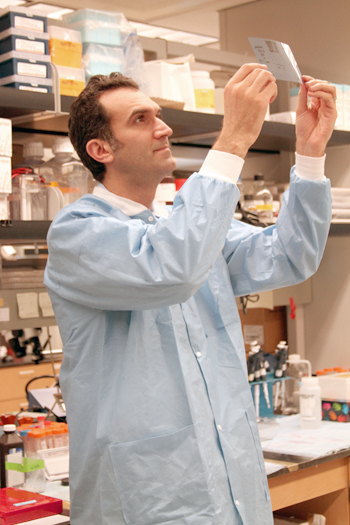School of Dentistry Seeks Mechanisms Behind Migraines
For scientists, finding the cause of migraine headaches has turned into a real brain teaser. Years of research on this debilitating condition have yet to uncover a definitive cause. While some migraine treatments have been developed, they are not effective for everyone. A University of Maryland School of Dentistry researcher has his mind set on exploring a new potential cause of migraine headaches.
Radi Masri, DDS, PhD, MS, associate professor in the Department of Endodontics, Prosthodontics and Operative Dentistry, has launched a collaborative project with Raimi Quiton, PhD, assistant professor in the Department of Psychology at the University of Maryland, Baltimore County (UMBC), titled “The Role of the Superior Colliculus in Migraine Pathophysiology.” The pair recently received a $75,000 University of Maryland, Baltimore-UMBC Research and Innovation Partnership Grant to fund their study.

Radi Masri, DDS, PhD, MS, associate professor at the School of Dentistry
The research is critical, Masri says, because migraines are far more than just a minor nuisance. The World Health Organization reports that migraine is the seventh most common cause of disability in patients. The severe headaches can last up to 24 hours and some patients experience two or three migraines each week.
In an effort to better understand this condition, Masri and his collaborators will focus on the superior colliculus, an area in the middle of the brain that receives information related to vision, hearing, and sensation. “Patients who suffer from migraine headaches are often very sensitive to light, sound, and touch,” explains Masri. “If there is a problem in the superior colliculus, it could explain that hyper-sensitivity.”
In a preliminary study, in collaboration with David Seminowicz, PhD, assistant professor in the Department of Neural and Pain Sciences at the School of Dentistry, the researchers found that patients who suffer from migraine headaches have an increase in blood oxygen levels in their superior colliculus. This increase signifies an abnormal activity in this region of the brain. They also discovered that the superior colliculus receives significant input from the dura, which is the super-sensitive tissue that surrounds the brain. Previous research has shown that sensitized nerves in the dura contribute to migraine headaches.
For the next phase of the study, Masri and his collaborators plan to study the brains of patients while they are actually experiencing a migraine, to evaluate changes in blood oxygen levels and see if a clearer picture emerges. In the long run, Masri is hopeful they can identify receptors and mediators that cause this abnormal activity, so they can develop treatments to more effectively block migraine headaches.
“The first step in finding a treatment for migraine is understanding what is actually happening in the brain,” Masri says. “The condition likely involves more structures in the brain than the superior colliculus, but the only way to gain a full understanding is to identify those structures one at a time.”



